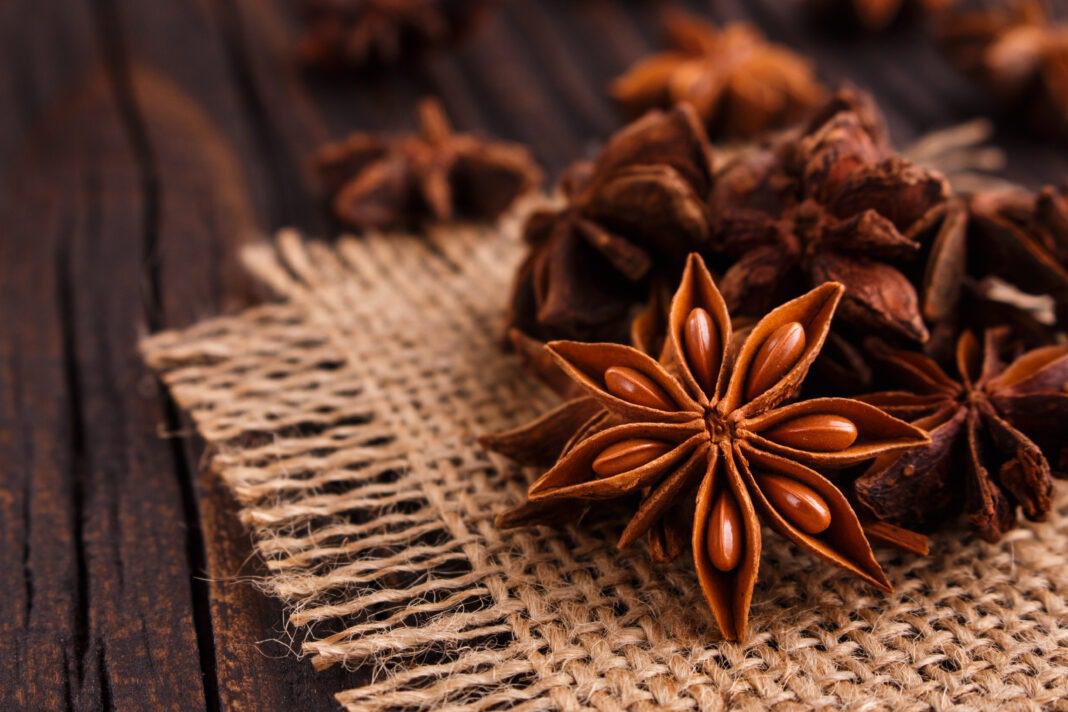Introduction
Star anise (Illicium verum of family Illiciaceae) is commonly known for its scented star-shaped spice used as a food flavor additive. Besides its shape and fragrance, it is also known as good herbal medicine. Star anise benefits are used during swine flu or bird flu and are also have antibacterial and antioxidant properties.
Star anise contains anethole, the same constituent that gives anise its distinctive sweet flavor with pleasant odor due to aromatic oils.
Important note
It is important to note that you should only use the Chinese variety don’t confuse it with Japanese star anise, which is toxic and poisonous not for taken don’t confuse it with Japanese star anise, which is toxic and poisonous not for taking.
Star anise uses
It is used as flavored rice (Pulav) and herbal tea for the treatment of colic and is popular among Caribbean and Latino populations. It is also used for dispelling cold, regulating the flow of Qi, and relieving pain.
Geographical distribution
It is native to northern Vietnam and southern China but also cultivated in France, Spain, Italy, and the Philippines.
History
Star anise is a common ingredient in traditional Chinese treatments for 3000 years for the treatment of various conditions, particularly skin inflammation, stomach aches, and rheumatic pain.
Constituents of Star Anise
Star anise contains a good amount of anethole, which is up to 95%. It also contains estragole, α-pinene, phellandrene, p-cymene, limonene, d-terpineol, and vitamin-like vitamin A, B, and C. Seed from the star anise floret is known to contain about 55% fatty oils along with oleic acid, linoleic acid, myristic acid, and stearic acid (1).
Health Benefits of Star anise
Star anise benefits carminative, stomachic, stimulant, antioxidant, antimicrobial, expectorant, analgesic, sedative, and diuretic properties as follows
1. Antimicrobial properties
Star anise contains antimicrobial compounds like trans-anethole which stop the growth of different bacteria yeast and fungal strains. Some of the examples are Acinetobacter baumannii, Pseudomonas aeruginosa, methicillin-resistant Staphylococcus aureus, Alternaria solani, Bipolaris maydis, Fusarium graminearum, Pythium aphanidermatum, Rhizoctonia solani, Aeromonas hydrophila, Aeromonas salmonicida, Edwardsiella tarda, Enterobacter (fish pathogen), Aspergillus flavus, A parasiticus, and Fusarium verticillioides (2,3).
2. Star anise helps in the treatment of swine flu/ bird flu
Star anise contains shikimic acid, one of the principal ingredients in Tamiflu (anti-flu drug) which is an influenza medication and also used for the treatment of bird flu/ swine flu (4).
3. Anticancer properties of monosaccharides present in Star anise
The monosaccharide in anise-like arabinose, xylose, and glucose shows a wonderful effect on reducing tumor size and volume, lowers oxidative stress, and increases the good enzyme. Which may play an important role in its anti-carcinogenic potential (5). Thus, the use of star anise for 6-20 weeks induces apoptosis and inhibits metastasis of different cancer cells such as colon and liver cancer (6).
4. High antioxidant properties of Star anise
It contains high antioxidant like vitamin C, phenolics and flavonoids which has more antioxidant activity as compared to others. Moreover, the daily consumption of star anise increases hemoglobin and red blood cells (7).
5. Insecticidal properties of Star anise
A good amount of trans-anethole in star anise shows insecticide effects against Myzus persicae and Sitophilus zeamais Motschulsky. Therefore, star anise shows wonderful acaricidal activity potentially useful in the control of pests (8, 9).
6. Treats Alzheimer’s disease due to Trans-anethole in star anise
Trans-anethole found in star anise which possesses muscle relaxant and anticholinesterase activity or the management of Alzheimer’s disease. Thus star anise plays an important role in the central nervous system and memory impairment (10).
7. Antiviral properties of Anise essential oil
Phenols phenylpropanoids and sesquiterpenes which show wonderful antiviral effect against Herpes simplex viruses (HSV-1 and 2). This oil interacts with virions or may mask viral compounds that are necessary for viral adsorption and thus inhibits the virulence of the virus (11).
8. Star anise enhance lactation
A research study done on sows and nursing piglets proved that daily supplementation of star anise improves the weaning weight of piglets, milk yield, and average daily feed intake (ADFI) of sows. Therefore, the consumption of star anise shows beneficial effects in improving the lactation performance of sows (12).
9. Antibiofilm properties
Staphylococcus aureus is a major human pathogen that develops biofilm formation for resistance to antibiotics. However, star anise inhibits S. aureus biofilm formation (13).
Side effects of Star anise
Star anise is safe but its consumption in excess can cause severe skin allergies.
Consumption of false star anise
Japanese star anise (I. anisatum L.) is a closely related species of Chinese star anise. It is not edible because it causes serious neurologic and gastrointestinal toxicities such as convulsions, diarrhea, and vomiting (14).
The risk for infant Neurotoxicities
Star anise contains toxic compounds such as veranisatins A, B, and C which is neurotropic compound and causes toxicity in infants with symptoms like tremors or spasms, hypertonia, hyperexcitability with crying, nystagmus, and vomiting (15). Therefore, star anise tea causes adverse neurologic reactions in infants (16).
